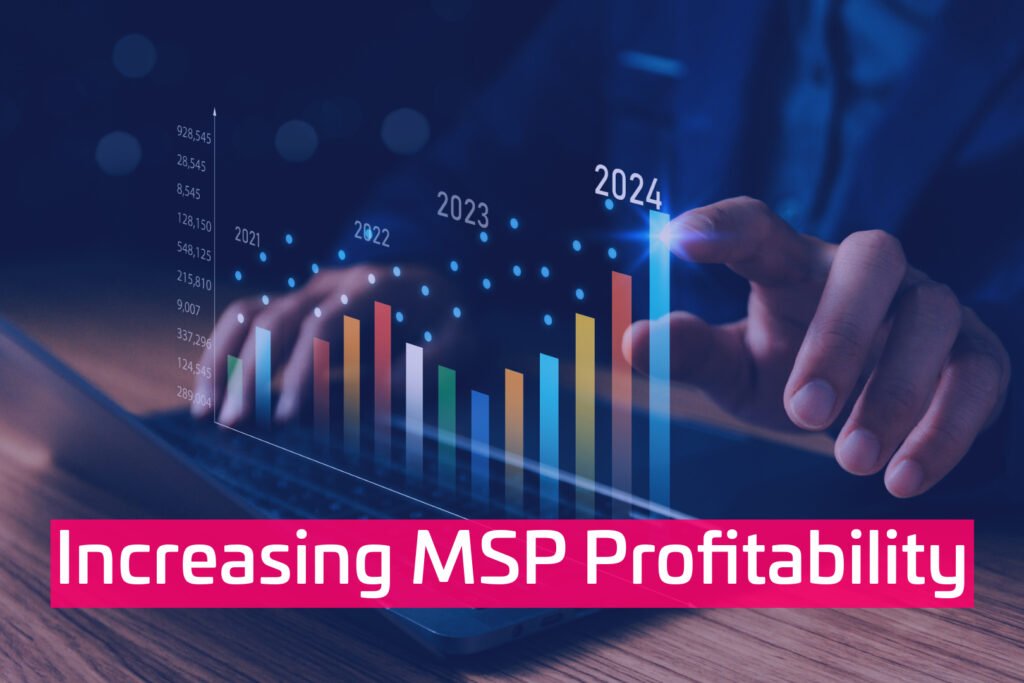The Three Levers To Control Profitability
In any business, there are three fundamental levers which ultimately dictates your profitability.
These are to Increase Revenue, Reduce Direct Costs and Reduce Overheads.
By improving in just one of the three, you will be increasing your net profit, but if you can tweak all three of them, you’ll be well on your way to ‘best in class’ (BIC) profitability within the MSP industry. This currently sits at around 21% EBITDA globally based on information published on Service Leadership Index (SLI).
Increasing Revenue – The Foundation of Profitability
Let’s first focus on how you can improve your MSP businesses revenue. The reality is, there are only two ways to increase revenue. Sell your products and services to more customers or sell your products and services for an increased price. A strategy which can incorporate both of these improvements will yield the best results and lead to faster growth.
It’s worth noting though that if your margins are consistent per customer, increasing prices will improve your gross margin (assuming costs remain consistent), whereas increasing the number of customers will increase your profit, but not your gross profit margin. Generally, increasing prices will lead to a bigger increase in profitability, however you need to ensure that you can retain and attract the right number of customers. It’s a key balance you need to get right in your business.
Winning new customers

Maximizing Gross Margin – The Role of Direct Costs
To calculate and measure your gross margin, you first need to calculate your gross profit, using the formula below:
Gross Profit = Revenue – Direct Costs (Costs of Goods Sold)
Your revenue is the total of everything you’ve sold, all products and services you’ve invoiced your customers.
The direct costs, sometimes referred to as Costs of Goods Sold or COGS is made up of all the costs which can be directly attributed against the products and services you sell.
For an MSP, your typical direct costs will be product related costs such as the laptops, desktops and servers you sell to your clients. From a service perspective, your direct costs might include your managed stack (RMM, EDR, Backups etc) as well as the salaries of any technical team who provide support and implementation services for your clients.
Your bookkeeping software – Xero, Quickbooks Online etc should have a chart of accounts configured which reflects the above and should make it very simple for you to get a gross profit figure.
Once you have your gross profit figure, simply divide it by your revenue to give you your gross margin:
Gross Margin = Gross Profit / Revenue
Therefore, by reducing your direct costs, you will increase your gross margin. So let’s take a look at some strategies to help with this.
Negotiate with Vendors:
Building strong relationships with vendors can lead to cost savings without sacrificing quality. Engage in win-win negotiations where both parties see value. As your MSP grows, leverage your increased purchasing power for better terms.
If you’re growing the number of customers/users that you manage, you can look to negotiate “Ramp Periods”, this is where you agree to a future minimum commitment, as a kind of target to achieve. You may receive a lower per user price from the start instead of having to wait until you’ve hit the next tiered discount level in the future.
Reducing these direct costs whilst maintaining or improving prices will lead to immediate gross profit boosts which will hit the bottom-line.
Seek out alternative vendors:
If you’re not getting anywhere with negotiations with your existing vendors, it might be worthwhile doing a review of the market. There could be other vendors that have recently entered the market with a rival product or service at a lower price.
This route should be carefully considered though. Changing vendors might require a significant investment in time and effort from your team, you will also need to get everyone trained up again with the new provider.
You will also need to do plenty of due diligence to ensure that the new product or service provides the required features and at a quality which either maintains or improves on what you were already receiving.
Reduce your operating expenses (Overheads)
Your net profit figure, often referred to as “the bottom line” is calculated by subtracting all of your fixed operating expenses (overheads) from your gross profit.
Net Profit = Gross Profit – Operating Expenses (Overheads)
We talked earlier about your direct costs, these are directly attributed costs towards the products or services you sell. Your overheads are all the other costs associated with the running of the business.
For example, your property expenses, sales & marketing or admin staff salaries, insurance, accountancy services etc.
This will be the final opportunity you have to increase your net profit, by reducing these costs or maintaining the percentage of overheads as you increase your gross profit margin.
Let’s dive into some ideas which might help you to achieve this.
Build efficiency and automation:
Slick, automated processes will help you to keep overheads down. Too often, companies add extra employees to perform basic administrative tasks which can be easily automated.
By automating admin tasks, you can seriously improve your profitability and it will also help you to scale more effectively. If you’re bogged down by admin every time you get a new lead or take on a new client, this will slow down growth.
Outsource Non-Core Functions:
Consider outsourcing functions that are not core to your MSP business, such as marketing, HR, or accounting. This can reduce the need for in-house staff in these areas and eliminate associated overheads like salaries and benefits.
Implement Remote or Hybrid Work Policies:
Allowing your staff to work remotely can reduce the need for large office spaces and associated costs like rent, utilities, and office supplies. Additionally, remote work can increase employee satisfaction and reduce turnover, indirectly reducing hiring and training costs.
What are you going to work on first?
Hopefully, this has given you some food for thought as to ways you can improve the profitability within your own MSP. If you want something to aim for, remember that the top 25% of MSPs are averaging 21% EBITDA (usually the same as net profit in most cases).
If you’re an owner of the business and you’re doing most of the day to day work in the business, factor in what a market rate salary should be for your role. If you’re not paying yourself that amount, you would need to deduct the difference from the profit before calculating the net profit percentage to make it realistic.
There’s no point saying you have a high profitability if it only just covers your salary and dividends for the year.
If you would like help with improving your MSPs profitability, we do offer one-to-one and group coaching at MSP Blueprint. Take a look at our MSP Coaching service for more details.




